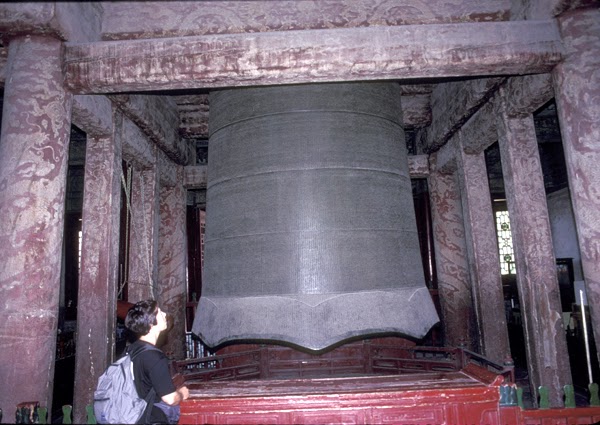 |
| The Great Bell of Beijing is rung to welcome the New
Year and to celebrate the full moon. |
More than six centuries ago, in the year 1402, the great Ming emperor, Yongle, began his reign over the vast kingdom of China. Yongle ordered workmen to build temples and palaces and to construct towers on the walls around the new capital, Beijing. He also decreed that a giant bell be made. It took more than twenty years and three castings to make the giant bell. Then Yongle died and the bell was forgotten.
 |
| Great Bell Temple, Beijing |
In 1577, Shen Dong, another Ming emperor, decreed that the giant bell be moved to the Temple of Longevity just outside the western gate of the city. After it was hung in the bell tower, a monk pulled back a wooden post and let it swing forward to strike the bell. At that moment, deep golden tones soared over the city. The monk struck the bell eighteen times quickly, eighteen times slowly, and then with eighteen quick-and-slow strokes together. At last the wish of Emperor Yongle was fulfilled. In 1743 the Temple of Longevity collapsed and the big bell was moved again, this time to the northwest part of Beijing to the Temple of Awakening, which was then renamed the Great Bell Temple.
 |
| Entrance to Bell Temple and Museum |
On our first trip to China, in 1995, Art and I made a point to visit the Great Bell Temple. I was intrigued because I had read in my guidebook that the heavy bell had been transported to the temple by sliding it along an icy path in winter. We were there on a hot summer day and the garden surrounding the temple was green and well tended and the lack of visitors and absence of souvenir booths and hawkers made it peaceful and pleasant. For an extra fee I climbed up the tower to view the bell from the top. I also bought a tape recording of bell sounds.
 |
| People from all over China come to the Great Bell Temple to
celebrate the New Year and pray for good luck by throwing coins into the
hole at the top of the bell. |
The Great Bell of Beijing weighs 46 tons. It is 22 feet tall, ten feet across, and eight inches wide at the thickest part of its wall. The 230,000 Chinese and Sanskrit characters on its surface form the words of more than one hundred Buddhist scriptures. Because of its size, the Great Bell is also sometimes called the King of Bells. The bell is noted for its fine workmanship and beautiful clear tone. With each stroke the sound vibrates for more than a minute and can be heard more than twenty-five miles away.
 |
| Bell Museum |
Part of the Temple is a Bell Museum. People in China have been making bells for more than three thousand years. The Great Bell of Beijing is a type of bell called a chung. A chung has no clapper; instead, it sounds when it is struck on the outside with a wooden post or mallet.
 |
| Beautifully decorated ancient bell |
Note: The Great Bell of Beijing is no longer the "King of Bells" -- that honor now goes to the 50-ton bell housed in the Altar to the Century (Zhonghua Shiji Tan), constructed in 1999 to celebrate the Millenium.
For information about visiting the Great Bell Temple and Bell Museum, click
HERE.






It’s great to stumble upon here and see the beauty of China! I love visiting the place most especially the food and the beautiful culture that they have. Unfortunately, I missed this place and it’s great to know where to go next if I visit China again! Awesome to learn!
ReplyDeleteMiranda Farley of
Apache Trail Tours